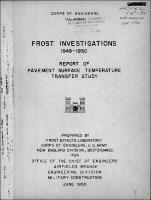Please use this identifier to cite or link to this item:
https://hdl.handle.net/11681/6555| Title: | Frost investigations, 1949-1950 : report of pavement surface temperature transfer study |
| Authors: | United States. Army. Corps of Engineers. New England Division |
| Keywords: | Airfields Runways Pavements Pavement bases Portland cement concrete Concrete Frost Frost action Frost penetration Frost heave Frost heaving Heat transfer Heat transmission Surface temperature Statistical analysis |
| Publisher: | Arctic Construction and Frost Effects Laboratory (U.S.) Engineer Research and Development Center (U.S.) |
| Series/Report no.: | Technical report (Arctic Construction and Frost Effects Laboratory (U.S.)) ; no. 31. |
| Description: | Technical Report Summary: Mathematical equations for predicting depths of frost penetration were developed as part of the Frost Investigations during 1944-1945. In the derivation of these equations the mean temperature at the pavement surface was assumed to be the same as the mean air temperature and the Freezing Index utilized in the equations was based on mean daily air temperatures. This simplifying assumption introduced an error of unknown magnitude as a difference between mean daily air and mean daily pavement temperatures is known to exist which is dependent on such factors as solar intensity, wind velocity, humidity, precipitation, latitude and the heat absorbing characteristics of the pavement. This report presents the results of a study to determine the relationship between the Freezing Indexes computed using mean air temperature and those computed using pavement surface temperature. The study is based on subsurface temperature data available at the Frost Effects Laboratory consisting of periodic subsurface temperature readings throughout a complete normal freezing period from three airfields and limited readings from a fourth airfield, all located in the northern part of the United States. From these readings a factor for modifying the Air Freezing Index is obtained and applied to the theoretical equations, and a correlation made between the observed depth and predicted depth of frost penetration. On the basis of these studies, the modified Air Freezing Index, or the Pavement Freezing Index, is of the order of 75 percent of the Air Freezing Index for bituminous concrete pavements and of the order of 90 percent of the Air Freezing Index for portland cement concrete pavements. The effect of the application of these ratios in predicting depth of frost penetration is presented. A more comprehensive study, based on continuous subsurface temperature readings correlated with mean daily air temperatures should be undertaken to produce ratio coefficients which when used with existing mathematical equations will result in more accurate predictions of frost penetration. |
| Rights: | Approved for public release; distribution is unlimited. |
| URI: | http://hdl.handle.net/11681/6555 |
| Appears in Collections: | Technical Report |
Files in This Item:
| File | Description | Size | Format | |
|---|---|---|---|---|
| ACFEL-Technical-Report-31.pdf | 2.49 MB | Adobe PDF |  View/Open |